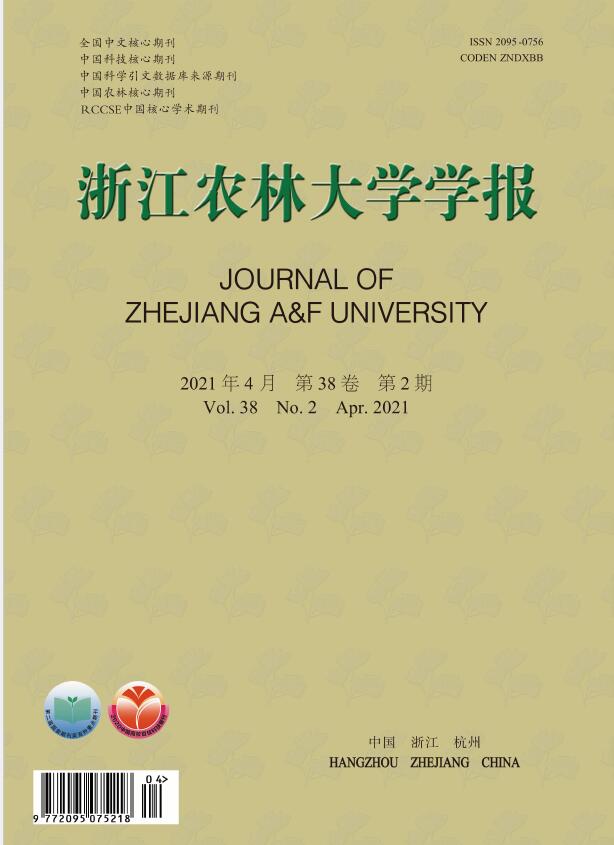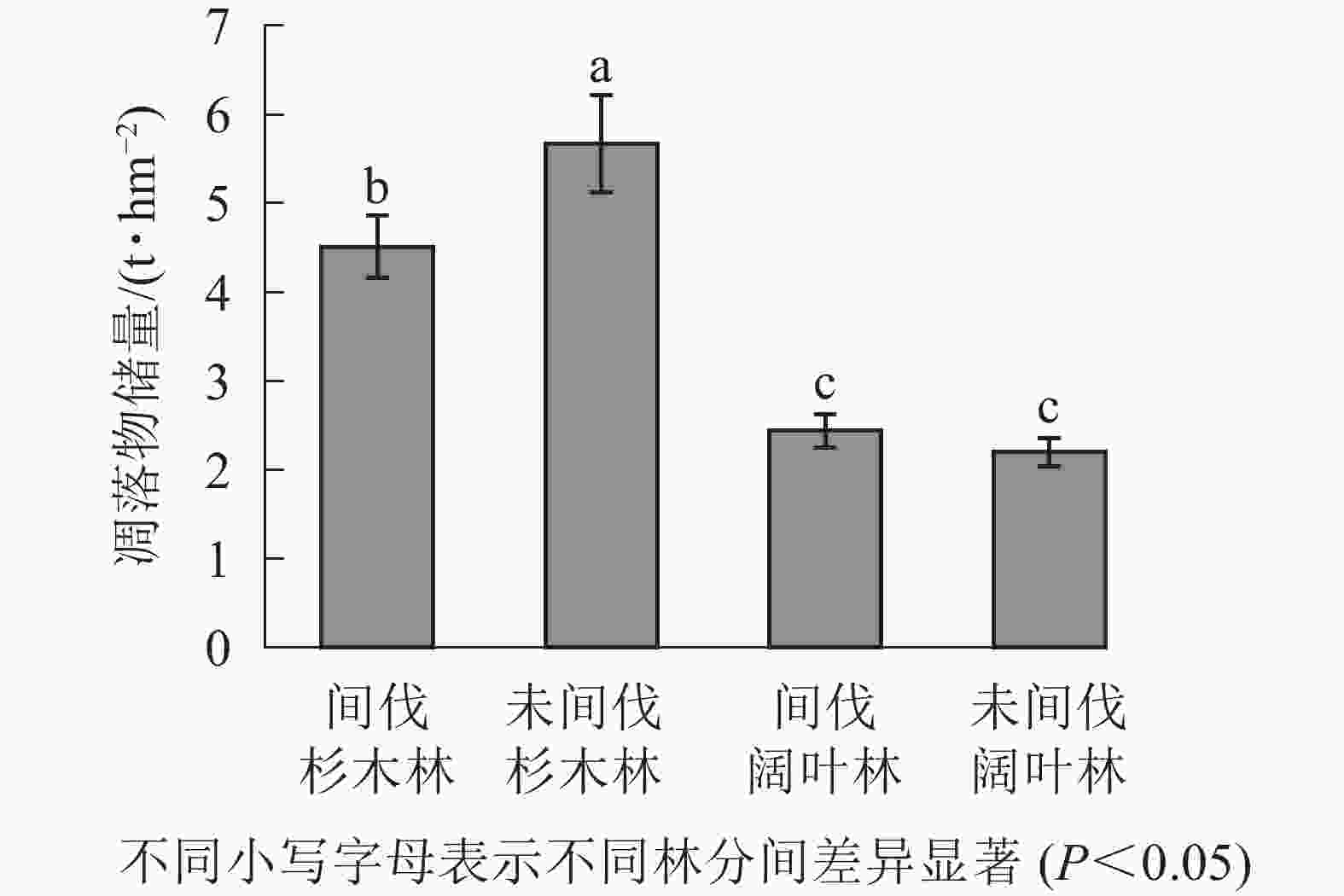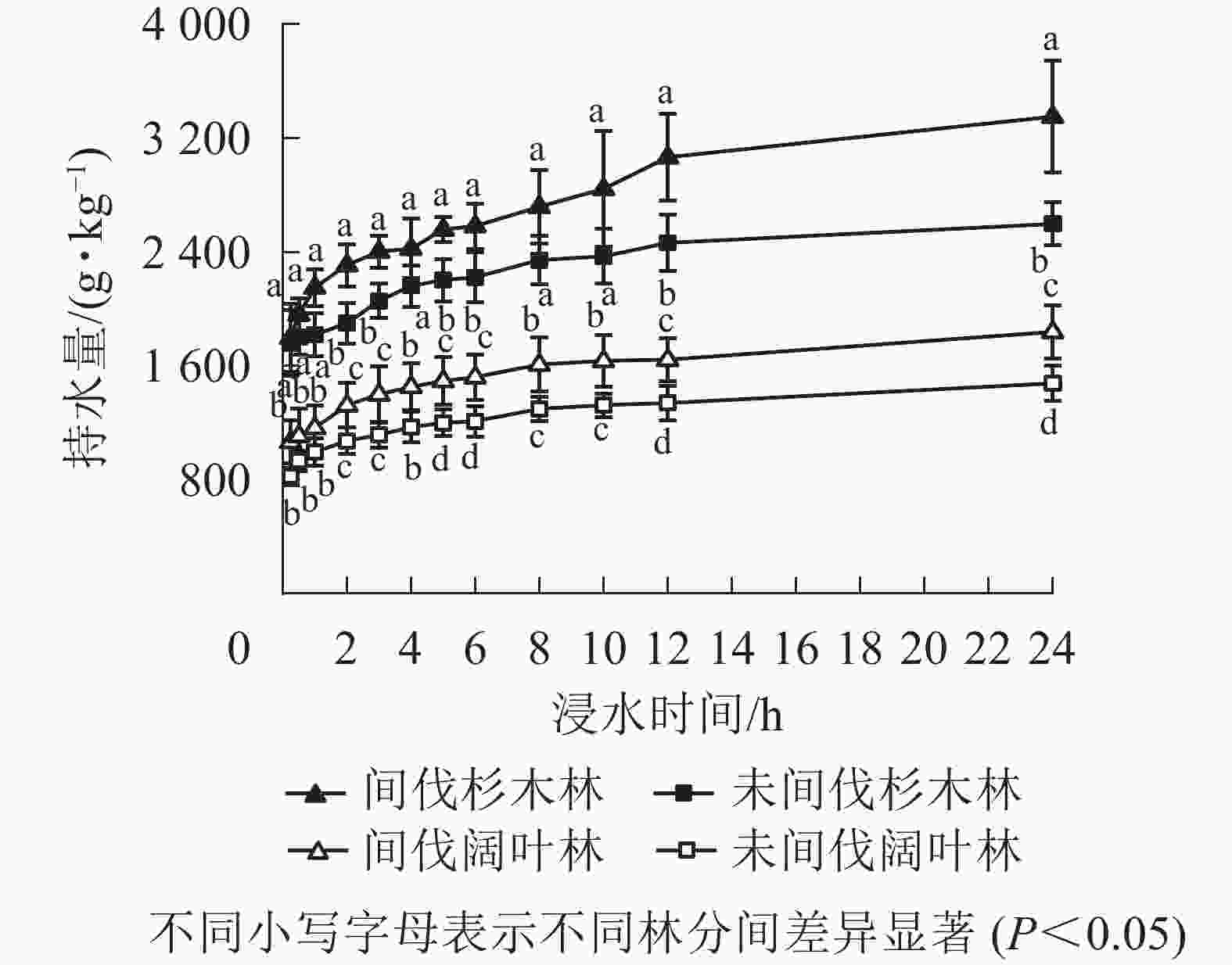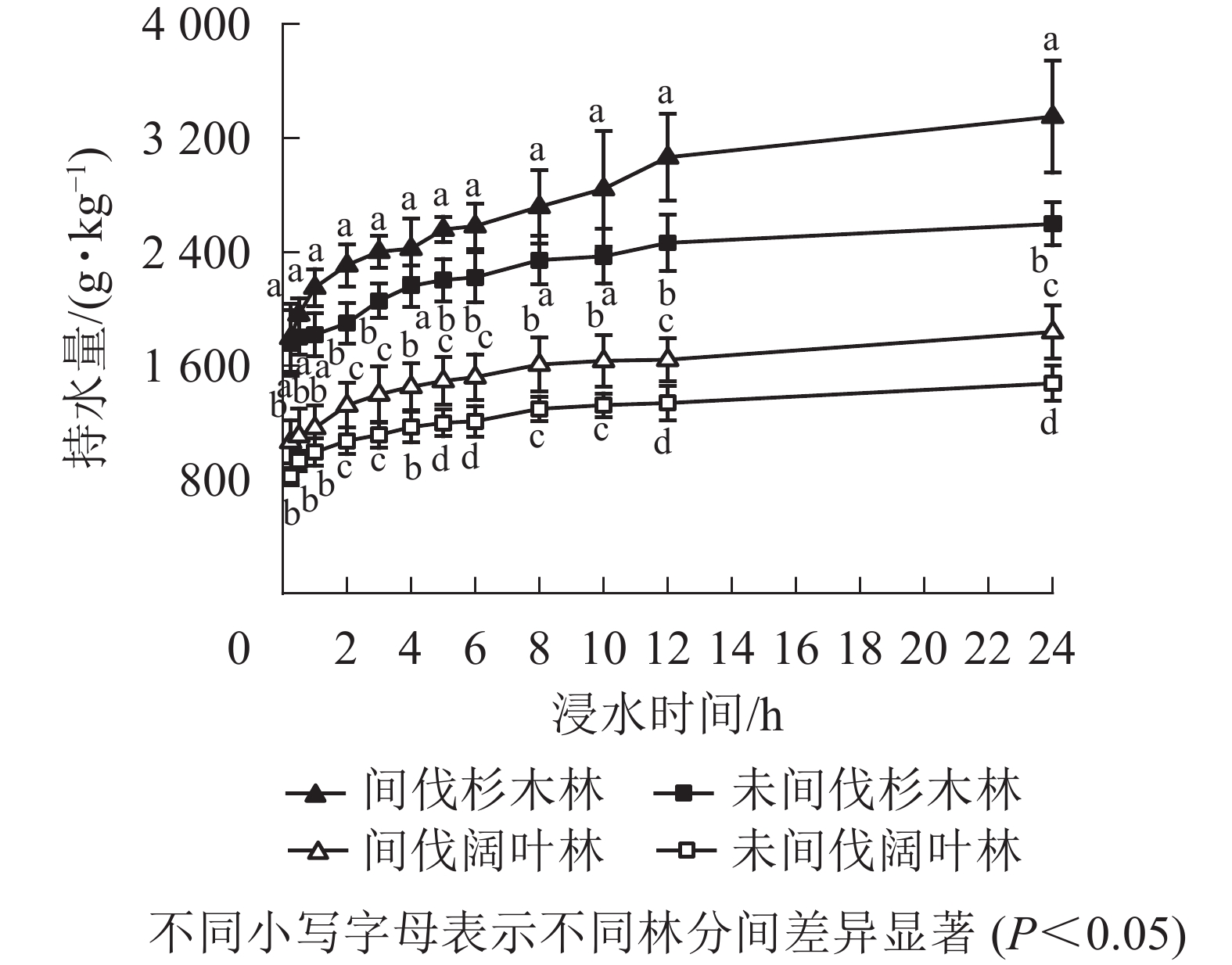-
水源涵养是森林最主要的生态功能之一,一直是生态学与水文学等相关学科研究的重点内容[1]。森林水源涵养功能表现在对降水的分配和运动作用上,其作用分为3个部分,即林冠层的截留、枯枝落叶层的吸持以及林地土壤的蓄水作用[2],其中凋落物层与土壤层的森林涵养水源能力占85%以上[3],已成为森林水文学研究的热点。近年来,众多学者开展了不同林分类型之间林下凋落物、土壤涵养水源能力的比较,以及针对单一林分类型进行抚育间伐来探讨间伐对森林水源涵养能力的影响。研究表明:林分类型对林下凋落物蓄积量、土壤孔隙度、凋落物持水量及土壤持水量存在影响[4-5]。森林抚育间伐可以调整森林生态系统结构,提高林地质量,增强林地水源涵养能力[6]。针对不同地域条件下,不同林分类型抚育间伐后在凋落物、土壤涵养水源能力方面的比较研究鲜有报道。林分类型不同,林下凋落物及土壤的涵养水源能力有所差别,但当林分密度同时发生改变时,林分之间的林下凋落物及土壤的涵养水源能力的关系是否发生变化呢?有鉴于此,本研究从野外采集凋落物与土壤,使用浸水法,全面调查和研究未间伐与间伐4 a的杉木Cunninghamia lanceolata林、阔叶林凋落物和土壤持水效能,旨在揭示间伐对杉木林和阔叶林凋落物储量、凋落物持水性能和土壤水文性质之间关系变化的影响,为揭示不同林分类型水源涵养功能提供科学依据。
HTML
-
研究区位于浙江省建德市新安江林场(29°29′N,119°16′E),属中亚热带季风气候,受新安江水库小气候影响,常年温暖湿润,降水量十分丰富。年平均气温为16.9 ℃,最热月7月平均气温为29.2 ℃,最冷月1月平均气温为4.7 ℃。年平均降水量为1 504.0 mm,年平均相对湿度为82%。年平均日照时数为1 940.0 h,年平均无霜期为254.0 d。年平均大雾日为33.0 d左右。土壤为发育于页岩的红壤土类。
研究区内主要森林类型有杉木林与阔叶林。阔叶林的主要树种有杜英Elaeocarpus decipiens、枫香Liquidambar formosana、樟树Cinnamomum camphora等。杉木林于1985年造林,初始密度为1 095株·hm−2;阔叶林于1990年造林,初始密度为2 505株·hm−2。
-
2014年10月,对浙江省建德市新安江林场范围内的杉木林、阔叶林进行较大面积间伐,以单位面积株数计,杉木林、阔叶林的间伐强度为45%~60%。为掌握间伐和林分类型对森林凋落物储量及土壤持水效能的影响,2019年9月,在3个小流域分别选取坡形、坡度、坡向等地形因子基本一致的2种林分类型(未间伐杉木林、未间伐阔叶林)和2种间伐类型(间伐杉木林、间伐阔叶林),不同处理样地面积为30~35 hm2,在不同处理林分中分别设置20 m×20 m的标准样地,调查乔木层胸径,并计算密度。不同处理林分的基本情况如表1所示。
处理 土壤类型 坡度/(°) 林龄/a 密度/(株·hm−2) 平均胸径/cm 未间伐杉木林 红壤 30 35 1 095 14.9 间伐杉木林 红壤 30 35 600 21.7 未间伐阔叶林 红壤 25 30 2 505 11.5 间伐阔叶林 红壤 25 30 1 005 15.5 Table 1. Basic situation of C. lanceolata and broad-leaved forest plots in different treatments
-
4个处理分别设置3个重复,共计12个标准样地。在12个标准样地中,分别在样地四角及中心位置选取1 m×1 m的小样方各5个,采集凋落物装入密封袋,并在小样方位置挖掘土壤剖面,分别取0~10、10~30、30~60 cm环刀样品。
-
将采集的凋落物带回实验室,称其自然状态质量及在85 ℃烘箱中烘至恒量的质量,以干质量推算凋落物的储量,并计算自然含水率。采用室内浸泡法,称取一定量烘干的凋落物样品放入尼龙网袋(已称量)中,再将装有凋落物的尼龙网袋放入装有清水的容器中,并使其完全浸没,在浸泡0.25、0.50、1.00、2.00、3.00、4.00、5.00、6.00、8.00、10.00、12.00、24.00 h后分别取出,待沥干多余水分(无水滴滴落时)称量,每次称量所得凋落物湿质量与干质量的差值,即为凋落物样品在不同浸泡时长的持水量,并由此计算各时间段的持水速率、最大持水量、最大持水率、最大拦蓄率、有效拦蓄率、有效拦蓄量[7]。公式如下:W0=M1−M0,Rm=W0/M0×100%,W1=M2−M0,R0=W1/M0×100%,Wm=(Rm−R0)M,W=(0.85Rm−R0)M。其中:W0为凋落物最大持水量(g),Rm为最大持水率(%),M0为样品干质量(g),M1为浸泡后凋落物质量(g),M2为样品鲜质量(g),R0为自然含水率(%),W1为样品自然含水量(g),Wm为最大拦蓄量(t·hm−2),W为有效拦蓄量(t·hm−2),M为凋落物蓄积量(t·hm−2),0.85为有效拦蓄系数。
-
用环刀法测定土壤容重、非毛管孔隙度、毛管孔隙度等[8]。非毛管土壤持水量计算公式为:S=10 000Pth[9]。其中:S为非毛管土壤持水量(t·hm−2),Pt为土壤非毛管孔隙度(%),h为土壤层厚度(m)。毛管土壤持水量计算公式为:Sn=10 000Pnh。其中:Sn为土壤毛管持水量(t·hm−2),Pn为土壤毛管孔隙度(%),h为土壤层厚度(m)。土壤最大持水量是指土壤孔隙全部充满水分时的含水量。它的计算公式为:Smax=10 000Pih。其中:Smax为土壤最大持水量(t·hm−2),Pi为土壤总孔隙度(%),h为土壤层厚度(m)。
-
采用SPSS 20.0软件进行数据统计分析,单因素方差分析(ANOVA),利用Duncan法进行多重比较和差异显著性分析(P<0.05),并利用Origin 2018软件绘制图形。
1.1. 研究区概况
1.2. 研究方法
1.2.1. 样地选择
1.2.2. 采样方法
1.3. 测定方法
1.3.1. 凋落物储量及持水性测定
1.3.2. 土壤物理性质和持水性能测定
1.4. 数据处理与分析
-
4种处理林分的凋落物总储量为2.20~5.67 t·hm−2,从大到小依次为未间伐杉木林、间伐杉木林、间伐阔叶林、未间伐阔叶林,其中未间伐杉木林凋落物储量显著高于未间伐阔叶林(P<0.05),间伐杉木林较未间伐杉木林凋落物储量显著降低了25.2%(P<0.05),而间伐阔叶林较未间伐阔叶林的凋落物储量只是略有升高(图1)。2种林分类型间伐前后凋落物储量表现有所差异,说明间伐和林分类型对凋落物蓄积量均有不同程度的影响。
-
随着浸水时间的增加,4种处理林分的凋落物持水量呈现“快—缓慢—稳定”的增加趋势。各处理林分在开始浸水时,持水速率相差较大。整个过程中,持水量从大到小依次均为间伐阔叶林、未间伐阔叶林、间伐杉木林、未间伐杉木林。间伐显著提高了杉木林凋落物在2.00、3.00、5.00、6.00、12.00和24.00 h的持水量,间伐显著提高了阔叶林凋落物在5.00、6.00、8.00、10.00、12.00和24.00 h的持水量(P<0.05,图2)。在开始浸泡时,凋落物的持水速率都很大,这是因为凋落物处于风干状态,此时凋落物的细胞和表面水势差较大,当浸入水中后,迅速吸水,导致持水速率较大。浸水1.00 h后,4种处理林分的凋落物总持水量分别占24.00 h的63.3%~70.0%。浸泡12.00 h后,凋落物持水量基本达到饱和状态,并且各林分凋落物持水速率在浸水0.25~0.50 h时急剧下降,1.00 h后持水速率基本稳定,当浸水1.00 h时持水量增长的速度和持水速率降低的速度都变缓,可见浸水1.00 h是凋落物发挥持水能力的关键时期(图2和表2)。其中,间伐阔叶林凋落物吸水率最大,前0.25 h的持水速率高达7 190 g·kg−1·h−1,显著高于未间伐杉木林(P<0.05,表2)。
浸水时间/h 持水速率/ (g·kg−1·h−1) 间伐杉木林 未间伐杉木林 间伐阔叶林 未间伐阔叶林 0.25 4266.6±225.6 b 3298.6±140.2 c 7190.0±483.5 a 7041.8±386.6 a 0.50 163.9±20.2 b 438.5±55.5 a 661.5±83.0 a 156.2±15.3 b 1.00 113.9±8.3 b 119.8±10.5 b 375.7±35.8 a 39.5±5.6 c 2.00 159.1±18.0 a 79.5±14.9 b 156.6±14.2 a 79.7±15.8 b 3.00 76.3±14.6 b 41.5±12.0 b 94.7±11.2 ab 158.1±17.5 a 4.00 53.4±6.3 b 55.3±8.6 b 21.3±5.1 c 104.6±10.9 a 5.00 41.1±4.7 b 29.9±10.6 b 135.0±16.8 a 41.0±9.0 b 6.00 27.3±3.5 a 11.3±1.9 b 23.1±2.6 a 19.2±3.2 a 8.00 44.0±4.9 a 43.5±12.1 a 67.9±13.2 a 60.8±11.8 a 10.00 12.8±3.8 b 13.0±1.8 b 62.7±15.8 a 13.1±4.0 b 12.00 4.0±0.6 c 7.3±1.0 c 111.0±13.4 a 47.1±6.3 b 24.00 16.3±3.4 ab 11.6±2.5 b 24.0±4.0 a 11.1±2.9 b 说明:不同小写字母表示林分间的差异显著(P<0.05) Table 2. Effects of stand types and thinning on water absorption rate of forest litters
通过拟合得知(表3),4种不同处理林分的凋落物持水量(y)与浸水时间(t)的关系,可以用多项式函数方程y=at2+bt+c进行拟合,它们之间的相关性达极显著水平(P<0.01);凋落物持水速率(y)与浸水时间(t)的关系,可以用幂函数方程y=at−b进行拟合,它们之间的相关性达显著水平(P<0.05)。
处理 凋落物持水量(y)与浸泡时间(t)的关系 凋落物持水速率(y)与浸泡时间(t)的关系 方程式 相关系数 方程式 相关系数 间伐杉木林 y=−1.607 5t2+85.37t+970.4 0.968 3** y=2 075.6 t−2.129 0.864 9* 未间伐杉木林 y=−1.252 6t2+67.24t+794.4 0.973 7** y=2 170.3 t−2.228 0.932 6* 间伐阔叶林 y=2.374 6t2+89.98t+1 799.7 0.965 5** y=3 209.1 t−1.933 0.779 8* 未间伐阔叶林 y=0.372 2t2+71.33t+1 657.3 0.980 6** y=1 635.1 t−1.877 0.704 8* 说明:* 表示0.05的显著水平,** 表示0.01的显著水平 Table 3. Regression equation and correlation between water-holding capacity or water absorption rate of litter and immersion timefor different treatments
-
间伐后的杉木林、阔叶林凋落物层有效拦蓄量、有效拦蓄率与最大持水率的变化趋势基本一致,其中间伐杉木林、间伐阔叶林凋落物层最大持水率分别较未间伐林分显著增加了24.4%和29.1% (P<0.05),间伐阔叶林凋落物最大持水量(8.2±0.5) t·hm−2,较未间伐阔叶林(5.7±0.8) t·hm−2显著增加了42.5% (P<0.05),并且间伐使阔叶林凋落物层有效拦蓄量显著增加了42.2% (P<0.05)。这些说明:间伐显著提高了林分凋落物的持水性能。间伐阔叶林最大持水率显著高于间伐杉木林(P<0.05),但两者最大持水量差异不显著(表4)。
处理 自然含水率/% 最大持水率/% 最大持水量/(t·hm−2) 最大拦蓄率/% 有效拦蓄量/(t·hm−2) 有效拦蓄率/% 间伐杉木林 21.4±2.2 b 183.9±29.3 c 8.0±2.4 a 162.5±40.4 c 5.9±1.7 ab 134.9±33.9 c 未间伐杉木林 33.9±0.8 a 147.8±11.3 d 8.4±1.3 a 113.9±10.5 d 5.4±0.9 ab 91.7±8.8 d 间伐阔叶林 19.8±0.7 b 335.2±20.4 a 8.2±0.5 a 315.5±38.6 a 6.4±0.5 a 265.1±32.7 a 未间伐阔叶林 15.1±4.5 c 259.7±11.3 b 5.7±0.8 b 244.6±10.9 b 4.5±0.7 b 205.6±9.4 b 说明:不同小写字母表示林分间差异显著(P<0.05) Table 4. Waterholding capacity of litter in different stand types
-
比较不同处理林分的土壤物理性质,结果如表5所示。随着土层深度的增加,各处理林分土壤容重呈现增大趋势,4种处理林分的3个土层的土壤容重从大到小依次均为间伐阔叶林、未间伐阔叶林、未间伐杉木林、间伐杉木林,其中在0~10、10~30 cm土层,间伐杉木林土壤容重较未间伐杉木林分别显著下降了15.5%和12.0%(P<0.05)。随着土层深度的增加,各处理林分土壤总孔隙度表现为降低的趋势,间伐杉木林的土壤总孔隙度在3个林分不同土层中始终最大,并在0~10、10~30 cm土层显著高于阔叶林的2个处理(P<0.05)。此外,间伐使杉木林10~60 cm土层非毛管孔隙度显著增加(P<0.05),却使阔叶林非毛管孔隙度仅在30~60 cm土层显著增加(P<0.05),说明间伐对土壤孔隙度的影响受林分种类的影响。
土层/cm 处理 土壤容重/
(g·cm−3)总孔隙度/
%毛管孔隙度/
%非毛管孔
隙度/%最大持水量/
(t·hm−2)毛管持水量/
(t·hm−2)非毛管持水量/
(t·hm−2)0~10 间伐杉木林 0.87±0.01 b 67.3±0.7 a 48.8±3.4 a 18.5±2.8 ab 672.7±6.9 a 488.1±34.0 a 184.7±28.3 ab 未间伐杉木 1.03±0.04 ab 62.9±1.4 ab 45.7±1.8 a 17.2±0.9 b 628.8±14.4 ab 457.2±17.7 a 171.7±8.7 b 间伐阔叶林 1.08±0.08 a 59.3±0.6 b 36.0±4.5 b 23.3±2.7 a 592.7±5.8 b 359.7±45.0 b 233.0±46.6 a 未间伐阔叶林 1.07±0.14 a 59.7±5.5 b 37.5±3.4 b 22.2±2.1 ab 597.0±54.5 b 374.7±34.4 b 222.3±21.1 ab 10~30 间伐杉木林 0.95±0.08 b 64.0±3.2 a 44.2±4.2 a 19.8±1.3 a 1 280.4±64.1 a 884.8±84.6 a 395.6±25.1 a 未间伐杉木 1.08±0.07 ab 60.3±2.8 ab 47.0±4.8 a 13.3±2.0 b 1 205.2±56.0 ab 939.7±95.6 a 265.5±41.0 b 间伐阔叶林 1.19±0.07 a 55.1±2.5 c 39.4±4.6 a 15.7±2.9 ab 1 102.2±50.3 c 787.6±92.16 a 314.6±57.7 ab 未间伐阔叶 1.16±0.03 a 56.4±0.9 bc 42.4±3.1 a 14.2±2.6 b 1 128.3±18.1 bc 847.0±62.2 a 281.3±51.8 b 30~60 间伐杉木林 1.04±0.03 b 60.7±0.9 a 42.0±1.1 a 19.3±0.8 a 1 822.1±27.1 a 1 244.7±33.8 a 577.5±22.9 a 未间伐杉木林 1.10±0.11 ab 59.6±4.4 ab 44.3±3.6 a 15.3±4.3 b 1 787.4±132.1 ab 1 328.2±107.1 a 459.2±125.3 b 间伐阔叶林 1.26±0.01 a 52.4±0.4 c 31.8±3.2 b 20.6±3.3 a 1 573.1±12.1 c 954.6±95.2 b 618.5±97.4 a 未间伐阔叶林 1.22±0.14 a 53.9±5.2 bc 40.0±4.5 a 13.9±3.6 b 1617.0±156.7 bc 1 198.8±134.4 a 418.2±108.8 b 说明:不同小写字母表示林分间的差异显著(P<0.05) Table 5. Soil property and waterholding quantity of different stand types
-
不同处理林分土壤的水分保蓄能力存在差异。同一土层的土壤最大持水量从大到小依次为间伐杉木林、未间伐杉木林、未间伐阔叶林、间伐阔叶林,间伐杉木林土壤(10~30 cm)的最大持水量显著高于阔叶林的2个处理(P<0.05),说明间伐杉木林土壤持水性能最好。同时,间伐使杉木林非毛管持水量在10~30、30~60 cm土层分别显著增加了49.0%和25.8%(P<0.05),使阔叶林非毛管持水量在30~60 cm土层显著增加了47.9%(P<0.05),而2个间伐处理的土壤非毛管持水量无显著性差异(表5)。土壤储水特性主要体现在土壤持水量大小。将不同处理林分各土层最大持水量相加,得到0~60 cm最大持水量为3 268.0~3 775.2 t·hm−2,杉木林与阔叶林这2种林分类型间存在显著性差异(P<0.05),并且不受间伐措施的影响。土壤非毛管持水量反映了土壤有效持水量,因此,将不同处理林分各土层非毛管持水量相加,得到0~60 cm土壤非毛管持水量(896.4~1 166.1 t·hm−2)。由图3可知:各处理林分非毛管持水总量存在差异,间伐杉木林较未间伐杉木林显著增加了29.2%(P<0.05),间伐阔叶林较未间伐阔叶林增加了26.5%(P<0.05),说明间伐能够改善土壤孔隙度,增加土壤有效持水量。
2.1. 不同林分类型凋落物储量及持水性能
2.1.1. 不同林分类型凋落物储量
2.1.2. 不同林分类型凋落物持水过程
2.1.3. 不同处理林分凋落物持水能力
2.2. 不同林分类型土壤物理性质及土壤持水性能
2.2.1. 不同处理林分土壤的物理性质
2.2.2. 不同处理林分土壤的持水性能
-
森林凋落物储量受凋落物的输入量、分解速度、累积年限、树种组成和林分密度、生态恢复措施等的综合影响[10-12]。在一定林分密度范围内,随着林分密度的增加或减小,林内凋落物储量随之增加或减小[13-14]。本研究中,间伐杉木林凋落物储量显著低于未间伐杉木林,这主要是由于间伐杉木林密度小于未间伐杉木林,通过间伐,林分密度的减少一方面减少了森林生物量,另一方面会使林分郁闭度降低,林内透光性增强,更利于凋落物的分解,使得凋落物积累量较未间伐杉木林显著减少。这与间伐华北落叶松Larix principis-rupprechtii凋落物储量低于未间伐华北落叶松的结果相似[15]。本研究中,间伐阔叶林凋落物储量高于未间伐阔叶林,但两者之间的差距较小,这主要是由于未间伐阔叶林林分密度过大,植株间竞争过大,导致植株生长受到影响,森林生物量较少;另一方面间伐的阔叶林生物量增加,同时林内增加的光照与地表温度加速凋落物的分解,最终两者之间凋落物储量差距不明显。这与间伐强度为50%的大兴安岭用材林的研究结果相似[16]。本研究中杉木林凋落物储量大于阔叶林,这与楠杆自然保护区不同植被类型凋落物储量的研究结果一致[17]。
不同处理林分凋落物持水性能和持水速率的变化具有相似的规律,这与浙江省主要森林类型的研究结果一致[4,11]。凋落物持水量与浸泡时间存在多项式函数关系,而凋落物持水速率与浸水时间的关系为幂函数。凋落物持水能力受树种组成、发育阶段、垂直结构及凋落物分解程度等因素的影响[18]。林分间伐后,凋落物的储量不同,持水能力也会有较大差异。本研究中,间伐林分凋落物最大持水率、有效拦蓄量、有效拦蓄率均大于相对应未间伐林分,其中最大持水率、有效拦蓄率有显著增加,这与小五台山华北落叶松林最大持水率在不同间伐强度间差异不显著的研究结果不一致[19],其原因可能是由于树种不同,凋落物的枝叶比例有差异。间伐杉木林凋落物最大持水量、有效拦蓄量与未间伐杉木林之间的差异不显著,这主要是因为凋落物最大持水量、有效拦蓄量与凋落物储量有密切关系。而间伐阔叶林凋落物最大持水量、有效拦蓄量较未间伐阔叶林显著增加,这是由于间伐增加了凋落物的持水效能。这与抚育间伐天然次生林显著增加了未改造林地凋落物最大持水量、有效拦蓄量的研究结果相似[20]。间伐阔叶林凋落物的最大持水量、有效拦蓄量稍大于间伐杉木林,未表现出显著性差异,这是由于不同树种间伐后凋落物储量、持水效能等变化情况不一致导致的。
土壤孔隙度直接影响土壤的通气性及渗透性能,土壤容重随着孔隙度的变大而减小,孔隙度越大土壤有机质含量越多,土壤结构越疏松,越有利于雨水下渗,减少地表径流[21]。间伐提高了杉木林各个土层土壤非毛管孔隙度和土壤总孔隙度,降低了各土层土壤的容重,改善了土壤水文物理性质,增强了各土层土壤蓄水能力。杉木林抚育间伐后,土壤的水文物理性质得到明显改善,这与抚育间伐不同龄林杉木人工林的研究结果一致[22]。间伐也提高了阔叶林各个土层非毛管孔隙度,但土壤容重却升高了,这与间伐强度为5%的秦岭林区锐齿槲栎Quercus aliena var. acuteserrate林的研究结果相似[23]。这可能是间伐过程中人为作业、踩踏等加大了土壤容重,而间伐后树木根系的死亡,增加了土壤非毛管孔隙度。土壤非毛管孔隙度是决定土壤储水量的重要因素,是影响森林土壤水源涵养及水土保持功能的主要因素[24]。抚育间伐后,杉木林和阔叶林不同深度土壤非毛管持水量增加,不同深度土壤间伐杉木林最大持水量均显著大于间伐阔叶林。土壤非毛管持水量随着林分的间伐而增大,最大持水量因林分不同间伐后表现出不同变化趋势。抚育间伐降低了林分密度,林内的凋落物更易分解,土壤的水文物理性质得以改善,土壤蓄水能力随之增强。
综上所述,间伐显著提高了杉木林和阔叶林凋落物的持水能力和土壤的持水性能,同时间伐改变了杉木林与阔叶林之间凋落物储量、凋落物持水性能的关系,4个处理中以间伐杉木林的凋落物和土壤整体水源涵养功能最强。













 DownLoad:
DownLoad:

